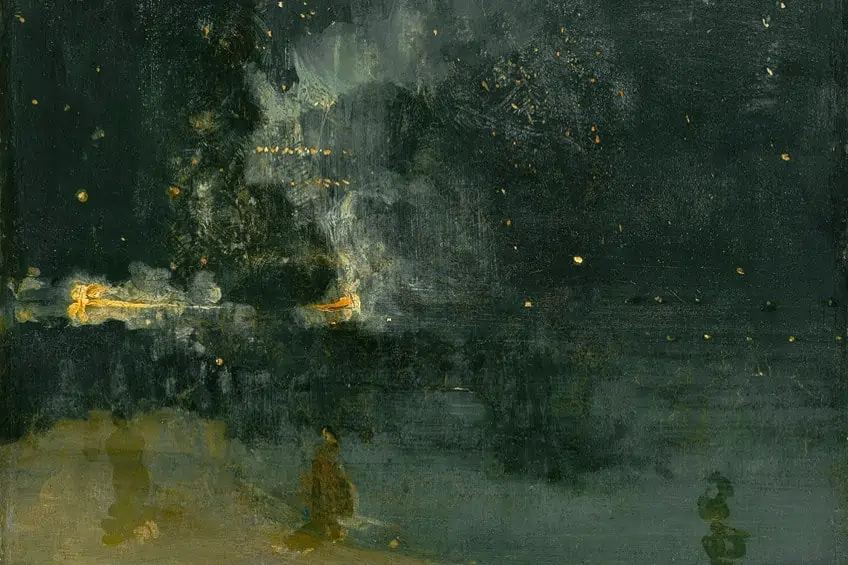Famous Night Sky Paintings – A Look at Popular Night Paintings
The night sky has been a source of inspiration for many areas of study, including art and science. Elements of the night sky such as the moon, sun, and stars feature in many early art forms as images of observation and an attempt at understanding the vastness of the universe and what it means for humanity. This article will introduce you to some of the most famous night paintings in art history.
The Night Sky in Painting
For centuries, humans have looked to the night sky for answers to life’s biggest questions around space, time, and even religion. What makes the evening sky an important topic of study in art is that it can provide us with valuable insight into the observations of the past concerning celestial objects and the way that artists have reimagined them. The importance of celestial bodies like the sun, moon, and stars has always been emphasized in art and science and holds much power over the way our lifestyles are governed.
As early as 8,000 BC, people were constructing monumental structures inspired by their observation of the solar and lunar movements, which functioned as an early clock and was one of the oldest forms of time measurement.
Another object from the Bronze Age is the Nebra Sky Disk, which is a circular flat piece of metal with a gold moon, sun, and stars that follow the pattern of the Pleiades constellation. Moving to Turkey in approximately 1,100 BC, there exists a pillar with etched images of animals mimicking the constellations in the sky. It is not hard to see why many of the great painters mentioned below, chose the night sky as a site of study.
The Top 10 Most Famous Night Sky Paintings
Among the astronomers and marines who meticulously studied the stars, some artists also decided to take an interest in the celestial objects above. Artists produced night paintings inspired by the aesthetic of the night sky as opposed to the mathematical and scientific need to observe and document the cosmos. For artists, the night sky was a pool of incredible untapped potential. Below, we will take you on a journey through the night sky as seen through the eyes of the creatives who made these famous night sky paintings.
Adoration of the Magi (c. 1304 – 1306) by Giotto di Bondone
| Artist | Giotto di Bondone (c. 1267 – 1337) |
| Date | c. 1304 – 1306 |
| Medium | Fresco |
| Dimensions (cm) | 200 x 185 |
| Where It Is Housed | Scrovegni (Arena) Chapel, Padua, Italy |
Painted by Giotto di Bondone between 1304 and 1306, this famous night sky painting, Adoration of the Magi, was commissioned by the businessman, Enrico Scrovegni, for display at the present-day Arena Chapel. One of the fresco’s many scenes portrays the Christmas star passing over the city of Bethlehem.
One of Bondone’s key features in large frescoes such as this one is the presence of a starry azure blue night sky created using an expensive blue pigment worth more than gold.
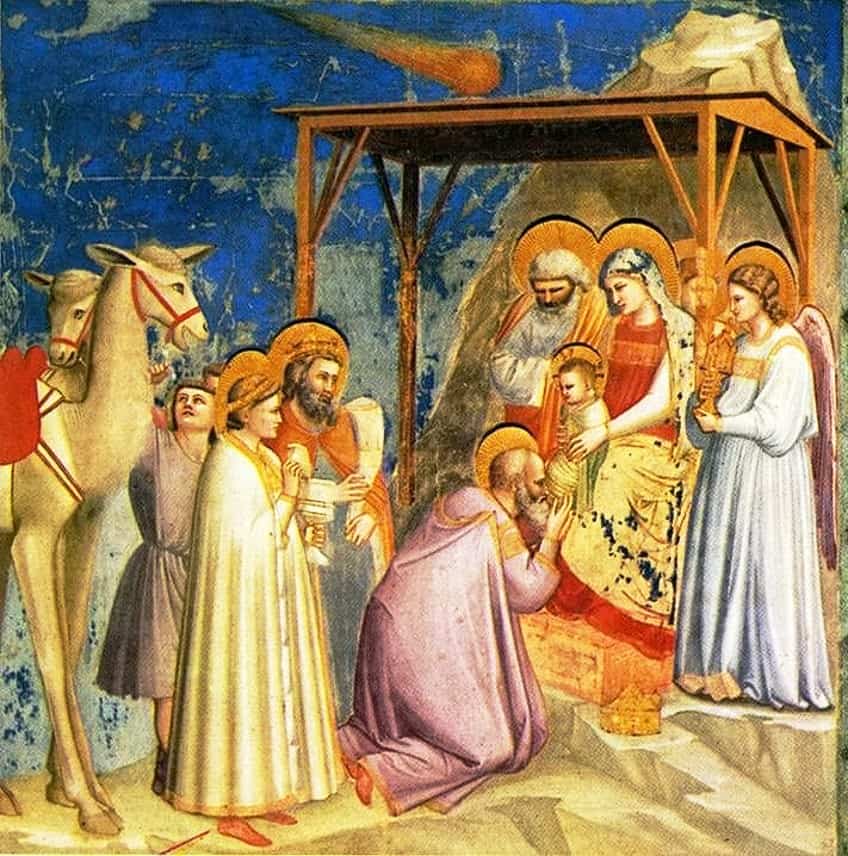
The main attraction, aside from Jesus Christ, is the Christmas star, which was a comet that passed over the Italian sky in 1301 called Comet Halley. During this time, Bondone was in Florence and would have witnessed this historical event alongside Dante Alighieri, the famous poet who criticized Enrico Scrovegni’s father for being a “notorious money-lender”.
Adoration of the Magi is considered an important painting for its display of the artist’s keen observation of the night sky and remains one of the few artists to provide modern-day scientists with a visually accurate image of the Comet Halley.
The Great Comet of 1680 Over Rotterdam (1680) by Lieve Verschuier
| Artist | Lieve Verschuier (1627 – 1686) |
| Date | 1680 |
| Medium | Oil on canvas |
| Dimensions (cm) | 25.5 x 32.5 |
| Where It Is Housed | Museum Rotterdam, Rotterdam, The Netherlands |
Painted in 1680, this gorgeous night sky painting by Lieve Verschuier illustrates a crowd observing the passing of the Comet Kirch over Rotterdam. The comet was spotted in December 1680 and shot over the town towards the sun.
In the painting, one sees a glowing reddish-orange light emanating from the comet as it passes over the town and illuminates the spectators and the landscape below it.
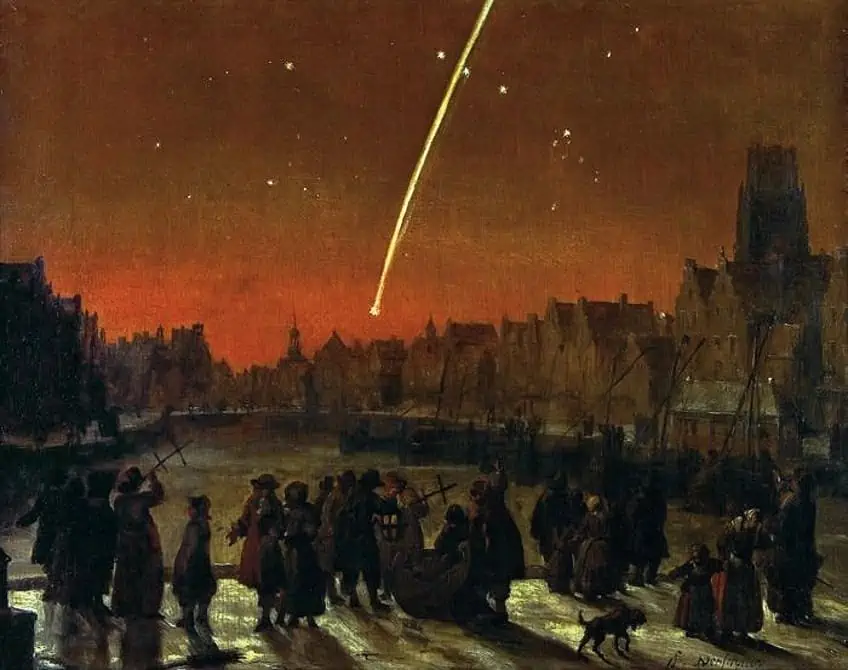
The spectators do not seem alarmed by the cosmic event and instead appear to observe and admire the comet with a sense of awe. During the production of this painting, the Age of Enlightenment was also at the peak of making its mark in European history and was characterized by the growth in the developments surrounding art and science.
The glow of the sky in Rotterdam today is said to bear a similar resemblance to the red-orange hue in the painting, attributed to light pollution.
Fishermen at Sea (1796) by J. M. W. Turner
| Artist | Joseph Mallord William Turner (1775 – 1851) |
| Date | 1796 |
| Medium | Oil on canvas |
| Dimensions (cm) | Support: 91.4 x 122.2, frame: 112 x 142.5 x 10.5 |
| Where It Is Housed | Tate Gallery, London, United Kingdom |
This Romantic maritime painting is also one of the most famous night sky paintings created by the master of marine and night paintings, Joseph Mallord William Turner. Turner excelled at applying the chiaroscuro painting technique, which involved the presence of high contrasts in painting to draw attention to a particular subject.
In Fishermen at the Sea, Turner highlights the dramatic waves of the sea through his mastery of illumination, as seen emanating from the majestic moon, which emerges from behind the cloudy night sky.
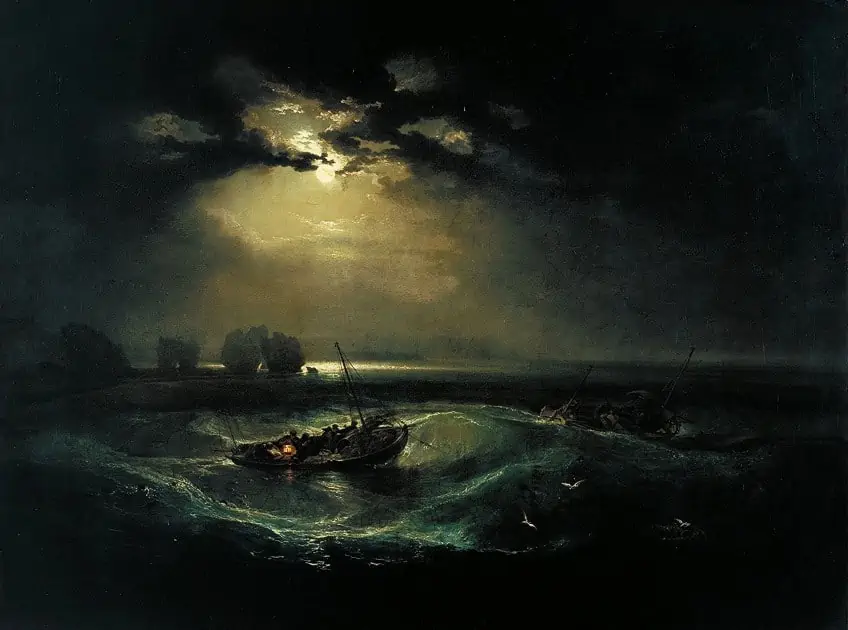
The sheer scale of the painting itself contributes to the underlying theme that speaks to the power of nature and the vastness of the sea, which makes the fishermen seem incredibly small and almost at the mercy of the sea. This painting is also known as Cholmeley Sea Piece and was first exhibited at the Royal Academy around 1796.
During its exhibition, the painting was well-received and is now known as one of Turner’s best maritime paintings.
Nocturne in Black and Gold, The Falling Rocket (1875) by James Abbott McNeill Whistler
| Artist | James Abbott McNeill Whistler (1834 – 1903) |
| Date | 1875 |
| Medium | Oil on canvas |
| Dimensions (cm) | 46.6 x 60.3 |
| Where It Is Housed | Detroit Institute of Arts, Michigan, United States |
This gold-framed night sky painting by American artist James Whistler is one of the most famous night sky paintings of the 19th century. Whistler was a strong advocate for the growing influence of the aesthetic approach of making art for art’s sake, which was considered a new art language.
Whistler was based in the United Kingdom for the majority of his artistic career but was also an active participant in the American Gilded Age.
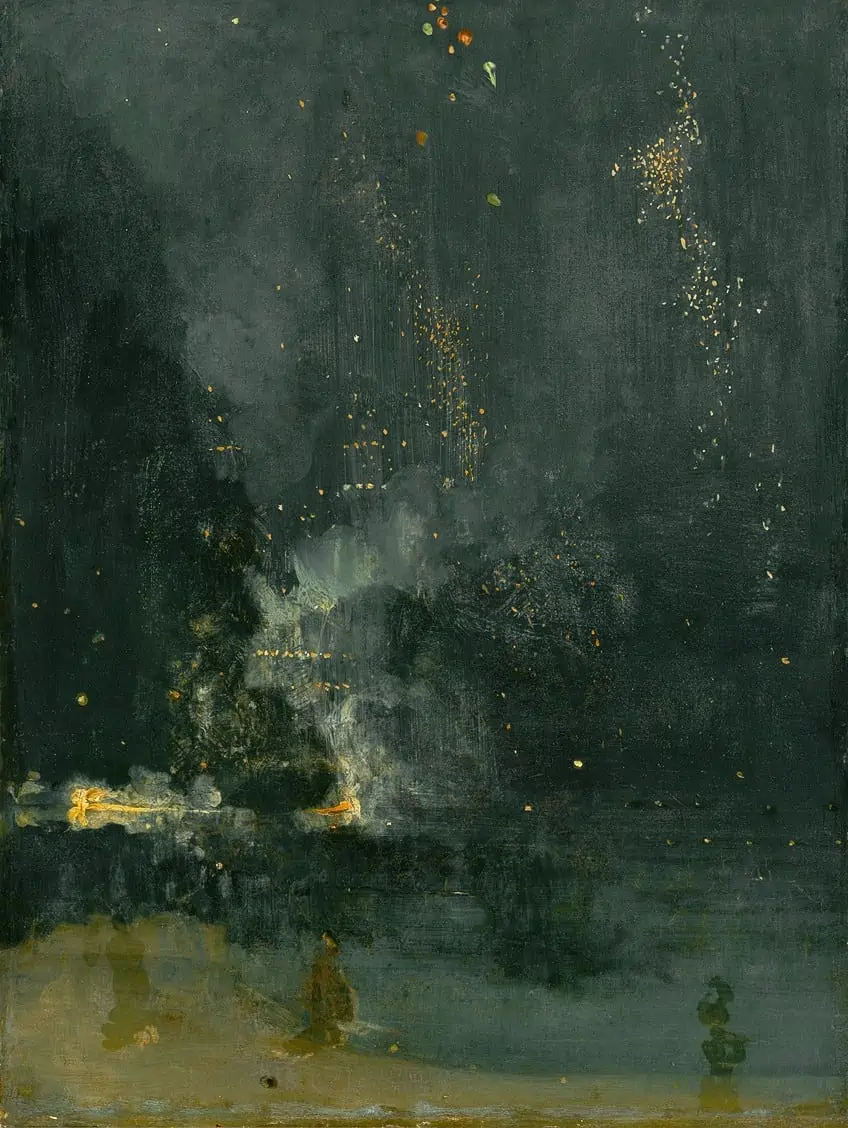
Nocturne in Black and Gold, The Falling Rocket is part of a series of night paintings that expresses the nature of the darkness at different moments during the evening. The focus of the series was based on the exploration of coloristic effects to evoke various sensations. This painting depicts a firework display in the industrial city park on a foggy evening.
The atmosphere is defined by Whistler’s color choice and instead of producing a realistic depiction of the scene, the artist chose to focus on the emotion embedded at that moment.
The Starry Night (1889) by Vincent van Gogh
| Artist | Vincent Willem van Gogh (1853 – 1890) |
| Date | 1889 |
| Medium | Oil on canvas |
| Dimensions (cm) | 92.1 x 73.7 |
| Where It Is Housed | The Museum of Modern Art, New York City, United States |
Perhaps the most famous night sky painting of all time, The Starry Night by post-Impressionist Vincent van Gogh, illustrates the dream-like appearance of the night sky over the French town of Saint-Rémy-de-Provence. Van Gogh was incredibly talented for his time and even though he did not sell as many paintings as one might think during his lifetime, his art can now be found on the list of the world’s most expensive paintings.
Van Gogh endured a mentally arduous life accompanied by depression, anxiety, and bouts of isolation.
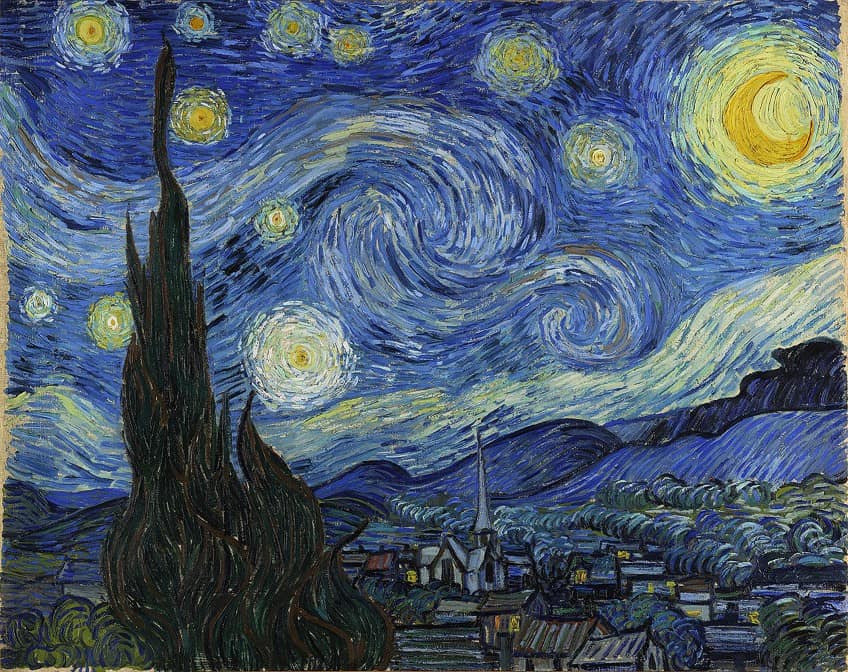
Despite the turmoil in the artist’s life, this starry night painting is among the first top three paintings associated with the artist and a popular depiction of the night sky. Its brilliance lies in Van Gogh’s signature style and use of unrealistic colors, which were executed using the impasto painting technique.
Van Gogh’s talent for creating these amazing swirls brings the scene to life and adds a sense of depth and body to the artificially-lit town.
Rainy Midnight (1890) by Childe Hassam
| Artist | Frederick Childe Hassam (1859 – 1935) |
| Date | 1890 |
| Medium | Oil on canvas |
| Dimensions (cm) | 46.4 x 54 |
| Where It Is Housed | The Museum of Fine Arts, Texas, United States |
This famous night sky painting by American Impressionist Childe Hassam was created around the late 1890s and portrays a rainy evening with an overcast blue night sky, visible to the viewer through the artificial street lights. Blue is a color frequently adopted to depict the night sky.
Together with the visual texture of the rain, Rainy Midnight provides the perfect visual of a softer, muted representation of the night sky.
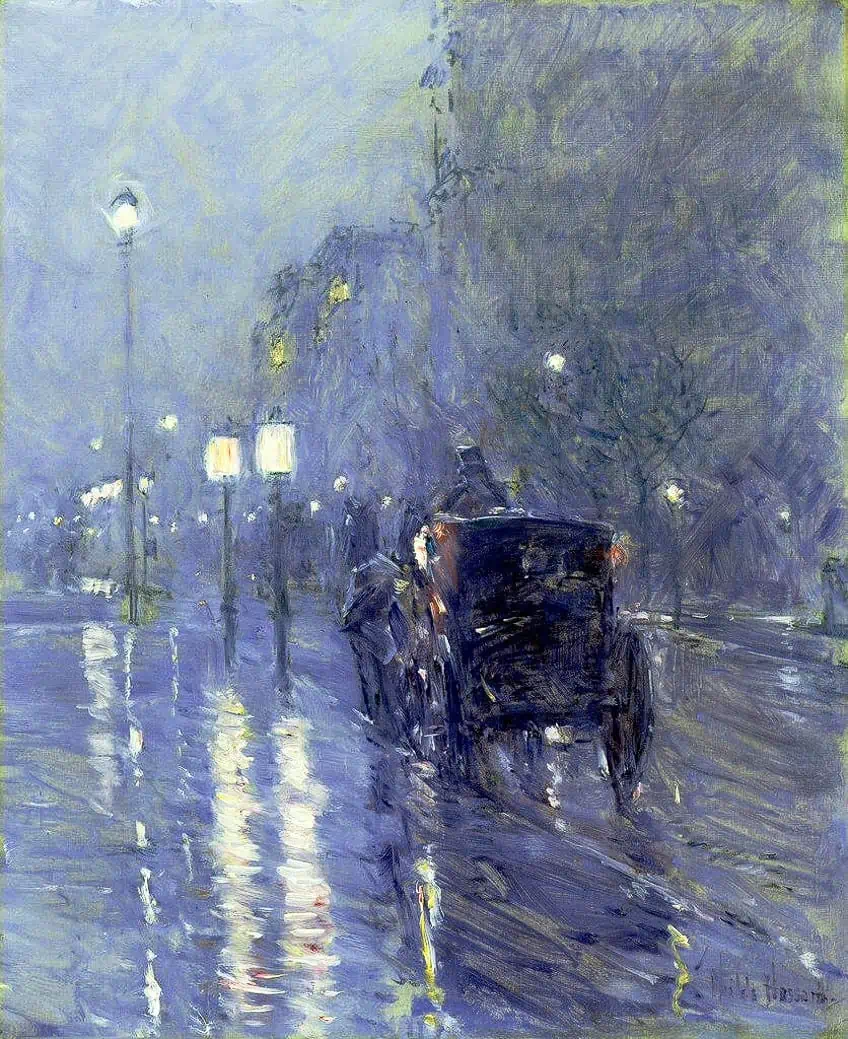
Moonlight, Wood Island Light (1894) by Winslow Homer
| Artist | Winslow Homer (1836 – 1910) |
| Date | 1857 |
| Medium | Oil on canvas |
| Dimensions (cm) | 78.1 x 102.2 |
| Where It Is Housed | The Metropolitan Museum of Art, New York City, United States |
Moonlight, Wood Island Light is an 1894 oil painting by famous American painter Winslow Homer who expertly portrayed the evening atmospheric conditions above the sea. Although Homer did not reach the same degree of fame as his contemporaries, his paintings were still admired for their dramatic compositions and realistic brushwork.
Homer’s studio was situated close to the sea on Wood Island.
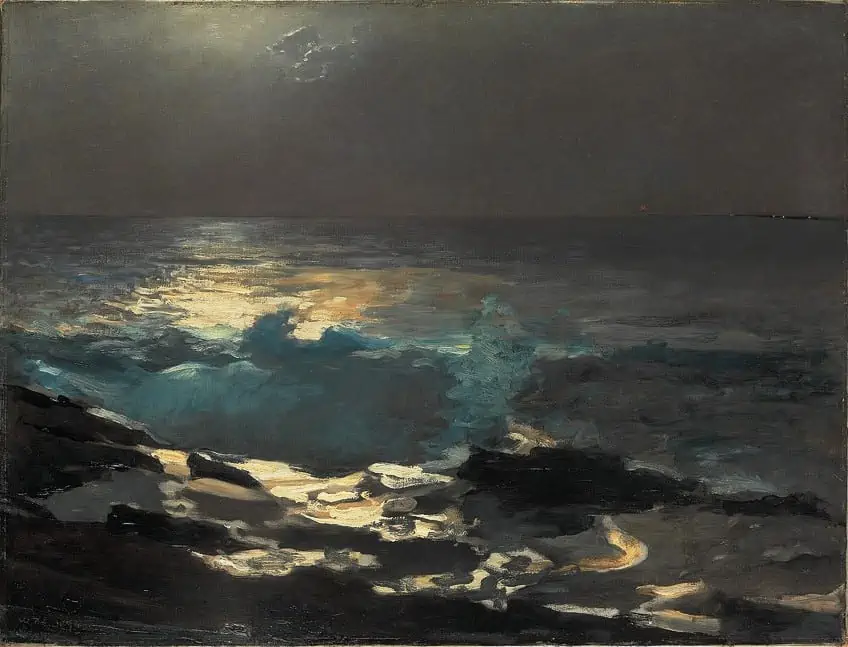
According to an account by William Howe Downes on how the painting was birthed, he recalled that Homer had a burst of artistic inspiration and leaped out of his studio toward the shore. The execution time of the painting took between four and five hours and was created entirely under the light of the moon, never to be retouched again. How incredible!
Boulevard Montmartre at Night (1897) by Camille Pissarro
| Artist | Camille Pissarro (1830 – 1903) |
| Date | 1897 |
| Medium | Oil on canvas |
| Dimensions (cm) | 64.8 x 53.3 |
| Where It Is Housed | National Gallery, London, United Kingdom |
Camille Pissarro was one of the most famous Impressionists of the 19th century who created this equally famous painting of the night sky in 1897. The painting portrays the busy Parisian nightlife of the Boulevard Montmartre in the aftermath of a downpour.
Pissarro masterfully applied abstract vertical shapes to portray the crowd passing by and included small markings of white paint to illustrate the minuscule stars in the sky as a finishing touch.
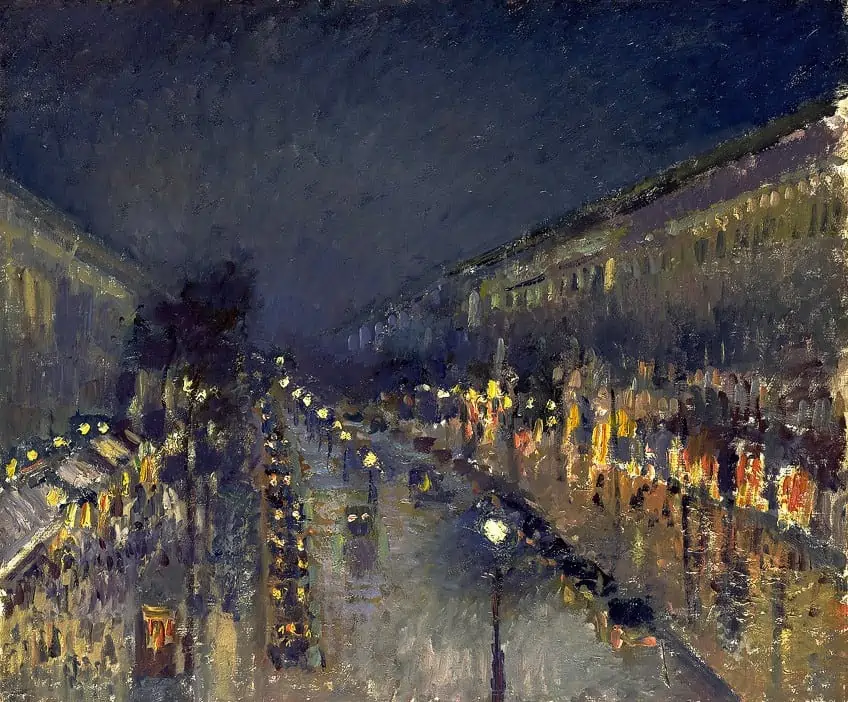
The painting is an excellent example of Pissarro’s talent in illustrating light under the night sky and includes a balance of the natural atmospheric light of the sky with the artificial light of the street lights. The Impressionist painting style also mimics the blurred visual of a glass covered with water droplets as if observing the street through a wet window.
The painting is also one of many other paintings of the boulevard of the same scene and angle but in different weather conditions.
The Moon (1928) by Tarsila do Amaral
| Artist | Tarsila de Aguiar do Amaral (1886 – 1973) |
| Date | 1928 |
| Medium | Oil on canvas |
| Dimensions (cm) | 110 x 110 |
| Where It Is Housed | The Museum of Modern Art, New York |
The Moon is a famous night sky painting by Brazilian artist Tarsila de Aguiar do Amaral, which was painted in 1928 and features an image of a crescent moon floating above an elliptical river stream. Amaral’s paintings often featured clear-cut lines with solid colors and elements of gradation, which made her compositions stand out at the time. The figure in the foreground is positioned directly under the moon and appears to bask in contemplation under its light.
The figure also bears the resemblance to that of a cactus while maintaining the form of a human figure.
The Mysteries of the Horizon (1955) by René Magritte
| Artist | René François Ghislain Magritte (1898 – 1967) |
| Date | 1928 |
| Medium | Oil on canvas |
| Dimensions (cm) | 110 x 110 |
| Where It Is Housed | The Museum of Modern Art, New York |
The Mysteries of the Horizon is one of the most famous night sky paintings of the 20th century, created in 1955 by the famous Belgian Surrealist René Magritte. In The Mysteries of the Horizon, Magritte evokes a sense of aloofness and isolation, despite the presence of other figures, as seen in the painting, which shares similar appearances.
Magritte’s paintings often incite the viewer to think critically about their perception of reality and included in the painting, three crescent moons above the figures of the men wearing bowler hats.
The painting takes on a philosophical framework and encourages the viewer to question the uniqueness of the figures, including their relation to each other, and their awareness of the environment. The color palette used for the night sky echoes blue with shades of indigo to emphasize the silence of the night.
The night sky was a rich source of creative inspiration for many artists for centuries and has resulted in some of the most beautiful renditions of cosmic events and nature’s best evening features. We hope that this article has inspired you to look to the stars during your next painting session.
Take a look at our night sky paintings webstory here!
Frequently Asked Questions
What Is the Most Famous Painting of the Night Sky?
The most famous painting of the night sky is The Starry Night by famous post-Impressionist painter Vincent van Gogh, created in 1889. The Starry Night shows the evening sky over the town of Saint-Rémy-de-Provence in France and is based on Van Gogh’s interpretation of the artificial lights in the town.
What Does the Sky Represent in Art?
In art, the sky represents infinity and transcendence. The image of the sky in art is also associated with the traditional beliefs of many cultures, often tied to ideas around omnipotence and universal order. The image of the sky can also represent immortality and be an inspirational theme.
What Is the Most Expensive Painting of a Night Sky?
The most expensive painting of a night sky is known to be Vincent van Gogh’s The Starry Night (1889), which is estimated to be worth $1 billion, since it is also the artist’s most recognized painting.
Jordan Anthony is a Cape Town-based film photographer, curator, and arts writer. She holds a Bachelor of Art in Fine Arts from the University of the Witwatersrand, Johannesburg, where she explored themes like healing, identity, dreams, and intuitive creation in her Contemporary art practice. Jordan has collaborated with various local art institutions, including the KZNSA Gallery in Durban, the Turbine Art Fair, and the Wits Art Museum. Her photography focuses on abstract color manipulations, portraiture, candid shots, and urban landscapes. She’s intrigued by philosophy, memory, and esotericism, drawing inspiration from Surrealism, Fluxus, and ancient civilizations, as well as childhood influences and found objects. Jordan is working for artfilemagazine since 2022 and writes blog posts about art history and photography.
Learn more about Jordan Anthony and about us.
Cite this Article
Jordan, Anthony, “Famous Night Sky Paintings – A Look at Popular Night Paintings.” artfilemagazine – Your Online Art Source. November 8, 2022. URL: https://artfilemagazine.com/famous-night-sky-paintings/
Anthony, J. (2022, 8 November). Famous Night Sky Paintings – A Look at Popular Night Paintings. artfilemagazine – Your Online Art Source. https://artfilemagazine.com/famous-night-sky-paintings/
Anthony, Jordan. “Famous Night Sky Paintings – A Look at Popular Night Paintings.” artfilemagazine – Your Online Art Source, November 8, 2022. https://artfilemagazine.com/famous-night-sky-paintings/.


